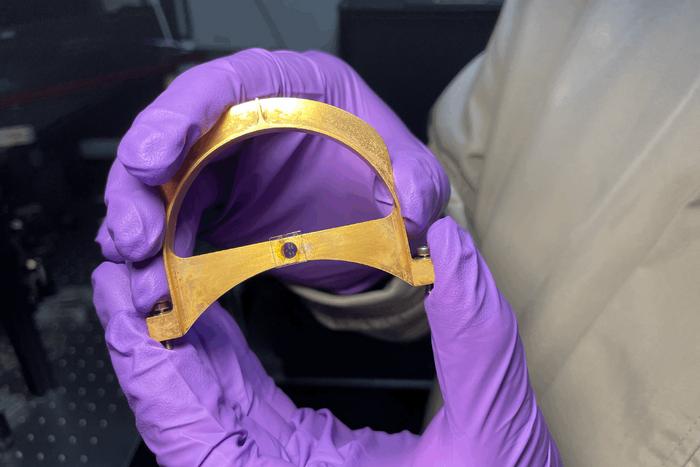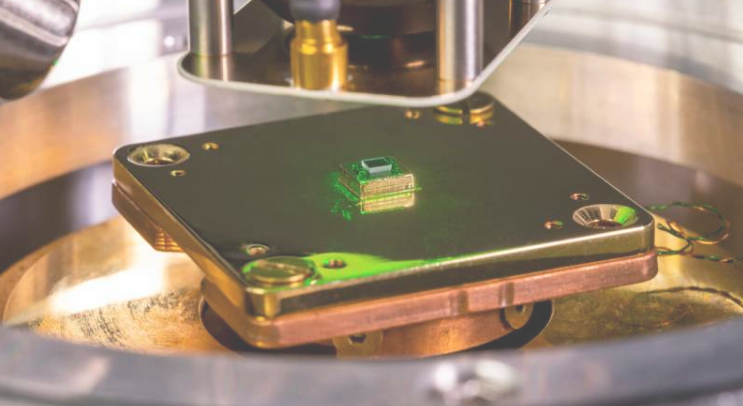Insider Brief PRESS RELEASE — Present-day quantum computers are big, expensive, and impractical, operating at temperatures near -459 degrees...
Vous n'êtes pas connecté
- English
- Français
- عربي
- Español
- Deutsch
- Português
- русский язык
- Català
- Italiano
- Nederlands, Vlaams
- Norsk
- فارسی
- বাংলা
- اردو
- Azərbaycan dili
- Bahasa Indonesia
- Հայերեն
- Ελληνικά
- Bosanski jezik
- українська мова
- Íslenska
- Türkmen, Түркмен
- Türkçe
- Shqip
- Eesti keel
- magyar
- Қазақ тілі
- Kalaallisut ; kalaallit oqaasii
- Lietuvių kalba
- Latviešu valoda
- македонски јазик
- Монгол
- Bahasa Melayu ; بهاس ملايو
- ဗမာစာ
- Slovenščina
- тоҷикӣ ; toğikī ; تاجیکی
- ไทย
- O'zbek ; Ўзбек ; أۇزبېك
- Tiếng Việt
- ភាសាខ្មែរ
- རྫོང་ཁ
- Soomaaliga ; af Soomaali
العناوين :
 Maroc - EURASIAREVIEW.COM - A la une - 22/06/2024 22:29
Maroc - EURASIAREVIEW.COM - A la une - 22/06/2024 22:29
A Quantum World On A Silicon Chip
The quantum internet would be a lot easier to build if we could use existing telecommunications technologies and infrastructure. Over the past few years, researchers have discovered defects in silicon — a ubiquitous semiconductor material —; that could be used to send and store quantum information over widely-used telecommunications wavelengths. Could these defects in silicon be the best choice among all the promising candidates to host qubits for quantum communications? "It’s still a Wild West out there,” said Evelyn Hu, the Tarr-Coyne Professor of Applied Physics and of Electrical Engineering at the Harvard John A. Paulson School of Engineering and Applied Sciences (SEAS). “Even though new candidate defects are a promising quantum memory platform, there is often almost nothing known about why certain recipes are used to create them, and how you can rapidly characterize them and their interactions, even in ensembles. And ultimately, how can we fine-tune their behavior so they exhibit identical characteristics? If we are ever to make a technology out of this wide world of possibilities, we must have ways to characterize them better, faster and more efficiently.” Now, Hu and a team of researchers have developed a platform to probe, interact with and control these potentially powerful quantum systems.; The device uses a simple electric diode, one of the most common components in semiconductor chips, to manipulate qubits inside a commercial silicon wafer.; Using this device, the researchers were able to explore how the defect responds to changes in the electric field, tune its wavelength within the telecommunications band and even turn it on and off. “One of the most exciting things about having these defects in silicon is that you can use well-understood devices like diodes in this familiar material to understand a whole new quantum system and do something new with it,” said Aaron Day, a Ph.D. candidate at SEAS. Day co-led the work with Madison Sutula, a research fellow at Harvard.; While the research team used this approach to characterize defects in silicon, it could be used as a diagnostic and control tool for defects in other material systems.; The research is published in Nature Communications. Quantum defects, also known as color centers or quantum emitters, are imperfections in otherwise perfect crystal lattices that can trap single electrons. When those electrons are hit with a laser, they emit photons in specific wavelengths. The defects in silicon that researchers are most interested in for quantum communications are known as G-centers and T-centers. When these defects trap electrons, the electrons emit photons in a wavelength called the O-band, which is widely used in telecommunications. In this research, the team focused on G-center defects. The first thing they needed to figure out was how to make them. Unlike other types of defects, in which an atom is removed from a crystal lattice, G-center defects are made by adding atoms to the lattice, specifically carbon. But Hu, Day and the rest of the research team found that adding hydrogen atoms is also critical to consistently forming the defect.; Next, the researchers fabricated electrical diodes using a new approach which optimally sandwiches the defect at the center of every device without degrading the performance of either the defect or the diode.; The fabrication method can create hundreds of devices with embedded defects across a commercial wafer. Hooking the whole device up to apply a voltage, or electric field, the team found that when a negative voltage was applied across the device, the defects turned off and went dark. “Understanding when a change in environment leads to a loss of signal is important for engineering stable systems in networking applications,” said Day, The researchers also found that by using a local electric field, they could tune the wavelengths being emitted by the defect, which is important for quantum networking when disparate quantum systems need to be aligned.; The team also developed a diagnostic tool to image how the millions of defects embedded in the device change in space as the electric field is applied. “We found that the way we’re modifying the electric environment for the defects has a spatial profile, and we can image it directly by seeing the changes in the intensity of light being emitted by the defects,” said Day. “By using so many emitters and getting statistics on their performance, we now have a good understanding of how defects respond to changes in their environment. We can use that information to inform how to build the best environments for these defects in future devices. We have a better understanding of what makes these defects happy and unhappy.” Next, the team aims to use the same techniques to understand the T-center defects in silicon.
Articles similaires
In Quantum Signaling Advance, Stanford Researchers Demonstrate ‘Smaller, Simpler, Cheaper’ Nanoscale Optical Device
Insider Brief PRESS RELEASE — Present-day quantum computers are big, expensive, and impractical, operating at temperatures near -459 degrees...
Diamond Defects, Now in Pairs, Reveal Hidden Fluctuations in the Quantum World
Insider Brief According to the Princeton University — In spaces smaller than a wavelength of light, electric currents jump from point to point and...
Diamond Defects, Now in Pairs, Reveal Hidden Fluctuations in the Quantum World
Insider Brief According to the Princeton University — In spaces smaller than a wavelength of light, electric currents jump from point to point and...
New Potential For More Affordable And Efficient Hydrogen Gas Production
A recent advance in the science of hydrogen fuel production could enable higher output and more sustainable production of this renewable energy...
Fraunhofer ISE achieves 30.6% efficiency for perovskite-silicon tandem based on industry-standard bottom TOPCon cell
Researchers at Fraunhofer ISE have developed a perovskite-silicon tandem solar cell using a TOPCon bottom cell with standard textured front surfaces....
Fraunhofer ISE achieves 30.6% efficiency for perovskite-silicon tandem based on industry-standard bottom TOPCon cell
Researchers at Fraunhofer ISE have developed a perovskite-silicon tandem solar cell using a TOPCon bottom cell with standard textured front surfaces....
Germanene breakthrough shows quantum states can toggle on and off with electric fields
Quantum materials just got a major jolt. Dutch researchers have shown, for the first time, that ultra-narrow strips of germanene, the lesser-known...
Germanene breakthrough shows quantum states can toggle on and off with electric fields
Quantum materials just got a major jolt. Dutch researchers have shown, for the first time, that ultra-narrow strips of germanene, the lesser-known...
Flow Trinidad promotes GBV campaign to save lives
After the deaths of two employees owing to gender-based violence (GBV) in 2021, Liberty Caribbean, the parent company of high-speed internet, phone...
أحدث الإصدارات
-
American Airlines invites AAdvantage members to help make a dierence this Giving Tuesday
AMERICAN AIRLINES - 01/12/2025
-
American Airlines to present at Goldman Sachs and Bernstein conferences
AMERICAN AIRLINES - 26/11/2025
-
American Airlines gets ready to unwrap deals for travelers this holiday season
AMERICAN AIRLINES - 25/11/2025
-
Belkin Expands Audio Range in the Middle East with SoundForm Anywhere True Wireless Earbuds
Belkin - 24/11/2025
-
Border Patrol Agents Face Shots Fired, Vehicle Rammings, Bricks Thrown in Chicago on Saturday
Amazon Web Service - 09/11/2025
-
Border Patrol Agents Face Shots Fired, Vehicle Rammings, Bricks Thrown in Chicago on Saturday
The Department of homeland security - 09/11/2025
-
ICE Arrests Worst of the Worst Criminal Illegal Aliens Including Pedophiles, Rapists and Violent Assailants
The Department of homeland security - 07/11/2025
-
DHS Sets the Record Straight on Misleading Video, Leaving Out Key Facts Including that the Woman Arrested Repeatedly Stabbed Her Coworker with Scissors
The Department of homeland security - 07/11/2025
-
United Airlines Launches MileagePlus Debit Rewards Card that Earns Miles for Spending and Saving
UNITED AIRLINES - 04/11/2025
-
American Airlines and AAdvantage members donate more than $1.2 million for Hurricane Melissa relief eorts
AMERICAN AIRLINES - 31/10/2025



